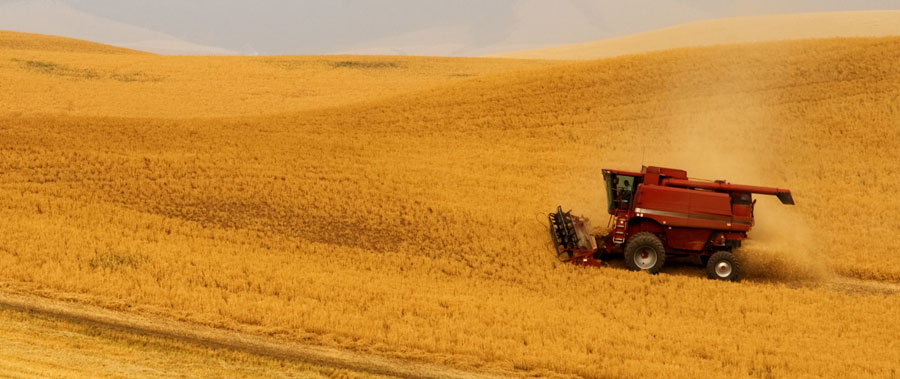All local governments in Washington state need to determine where natural resource industries, including forestry, agricultural, mining, and fisheries industries, can productively operate. They must use land-use controls to designate and conserve the necessary lands and to avoid conflicts with these industries from other land uses.
About natural resource-based lands
Natural resource-based lands such as those used for agriculture, forestry, and mining are identified in the Washington Growth Management Act (GMA) with specific provisions. The 8th planning goal of the GMA in RCW 36.70A.020 is to “Maintain and enhance natural resource-based industries, including productive timber, agricultural, and fisheries industries. Encourage the conservation of productive forestlands and productive agricultural lands, and discourage incompatible uses.”
Natural resource lands are agricultural, forest, and mineral lands. RCW 36.70A.170 required that all counties and cities designate:
- Agricultural lands that are not already characterized by urban growth and that have long-term significance for the commercial production of food or other agricultural products.
- Forestlands that are not already characterized by urban growth and that have long-term significance for the commercial production of timber.
- Mineral resource lands that are not already characterized by urban growth and that have long-term significance for the extraction of minerals.
RCW 36.70A.060 also requires that all fully planning jurisdictions adopt development regulations to conserve designated resource lands. Partially planning jurisdictions are required, at a minimum, to designate natural resource lands.
The requirements to classify, designate, conserve and protect these lands are in recognition of the essential role of these lands in supporting economic productivity and healthy ecological systems.
As part of the periodic review process required by RCW 36.70A.130(1), cities and counties should review and, if needed, revise policies and development regulations regarding natural resource lands.
Mineral resources are sand, gravel, and valuable metallic substances (WAC 365-190-070). Sand, gravel, or crushed stone are also known as aggregate resources. Aggregate resources are necessary to manufacture concrete, cement, asphalt, and other similar products, of which our roads, cities, and homes are built.
As part of required periodic updates required under RCW 36.70A.130(1), jurisdictions must review their mineral resource lands designations. In their review, counties or cities shall take into consideration any new information made available since the adoption or most recent review of its designations or development regulations and any new or modified model development regulations for mineral resource lands.
Resources
The Washington Geological Survey (WGS) is part of the Department of Natural Resources (DNR). WGS’s aggregate resource mapping projects identify aggregate mineral resources on a county-by-county basis. These projects provide data, maps and technical assistance to jurisdictions.
The GMA agricultural resource land designation criteria are established in WAC 365‐190‐050. It lists factors that should be considered when designating agricultural lands. Lands should be considered for designation as agricultural resource lands based on three factors:
- The land is not already characterized by urban growth.
- The land is used or capable of being used for agricultural production.
- The land has long-term commercial significance for agriculture.
When classifying, designating, and de-designating agricultural resource lands, counties must conduct a comprehensive countywide analysis, and should not review resource lands on a parcel-by-parcel basis.
Once lands are designated, fully planning counties and cities act must adopt development regulations that assure the conservation of agricultural resource lands. Recommendations for those regulations are found in WAC 365-196-815.
Resources
Criteria for classifying, designating, and de-designating forest resource lands of long-term commercial significance is provided in WAC 365‐190‐060(2). Again, counties must approach the effort as a county-wide or regional process. Cities are encouraged to coordinate their forest resource lands designations with their county and any adjacent jurisdictions. Counties and cities must have a program for the transfer or purchase of development rights prior to designating forest resource lands in urban growth areas.
Resources
DNR’s Forest Regulation program administers the rules that protect Washington’s state-owned and private forestlands. The program also assists Washington’s family forest owners through its Small Forest Landowner Office, by providing technical and financial assistance.
Resources
- Designation of Agricultural Lands in Chelan, King, Lewis, and Yakima Counties, 2004 (PDF)
- Designation of Mineral Resource Lands under the Growth Management Act (PDF)
Legal Basis
- Chapter 36-70A-060 RCW – Natural Resource Lands
- Chapter 365-190 WAC – Minimum Guidelines (recently updated)
- Chapter 365-195 WAC – Best Available Science (recently updated)
- Chapter 365-196-480 WAC – Natural Resource Lands (recently updated)
- Chapter 365-196-815 WAC – Conservation of Natural Resource Lands

